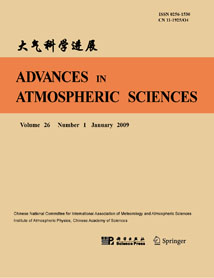| [1] |
Hongxiong XU, Dajun ZHAO,
2021: Effect of the Vertical Diffusion of Moisture in the Planetary Boundary Layer on an Idealized Tropical Cyclone, ADVANCES IN ATMOSPHERIC SCIENCES, 38, 1889-1904.
doi: 10.1007/s00376-021-1016-z
|
| [2] |
Hongxiong Xu, Dajun Zhao,
2023: Effect of the vertical diffusion of moisture in the planetary boundary layer on an idealized tropical cyclone, ADVANCES IN ATMOSPHERIC SCIENCES.
doi:
|
| [3] |
Duan Tingyang, Elmar R. Reiter,
1990: Some Characteristics of Cumulus Convection over the Tibetan Plateau, ADVANCES IN ATMOSPHERIC SCIENCES, 7, 87-97.
doi: 10.1007/BF02919171
|
| [4] |
S. S. Vaidya, V. N. Lykossov, S. S. Singh,
1993: Effect of Counter-Gradient in the Computation of Turbulent Fluxes of Heat and Moisture in a Regional Model, ADVANCES IN ATMOSPHERIC SCIENCES, 10, 85-94.
doi: 10.1007/BF02656956
|
| [5] |
Hongrong SHI, Hongbin CHEN, Xiang'ao XIA, Xuehua FAN, Jinqiang ZHANG, Jun LI, Chao LING,
2017: Intensive Radiosonde Measurements of Summertime Convection over the Inner Mongolia Grassland in 2014: Difference between Shallow Cumulus and Other Conditions, ADVANCES IN ATMOSPHERIC SCIENCES, 34, 783-790.
doi: 10.1007/s00376-017-6284-2
|
| [6] |
JIANG Xiaoping, ZHONG Zhong, LIU Chunxia,
2008: The Effect of Typhoon-Induced SST Cooling on Typhoon Intensity: The Case of Typhoon Chanchu (2006), ADVANCES IN ATMOSPHERIC SCIENCES, 25, 1062-1072.
doi: 10.1007/s00376-008-1062-9
|
| [7] |
PENG Jingbei, SONG Zhengshan,
2003: Heat and Moisture Budgets during the Period of HUBEX/GAME in the Summer of 1998, ADVANCES IN ATMOSPHERIC SCIENCES, 20, 245-251.
doi: 10.1007/s00376-003-0010-y
|
| [8] |
Lei LIU, Guihua WANG, Ze ZHANG, Huizan WANG,
2022: Effects of Drag Coefficients on Surface Heat Flux during Typhoon Kalmaegi (2014), ADVANCES IN ATMOSPHERIC SCIENCES, 39, 1501-1518.
doi: 10.1007/s00376-022-1285-1
|
| [9] |
CHEN Jinbei, HU Yinqiao, ZHANG Lei,
2007: Principle of Cross Coupling Between Vertical Heat Turbulent Transport and Vertical Velocity and Determination of Cross Coupling Coefficient, ADVANCES IN ATMOSPHERIC SCIENCES, 24, 89-100.
doi: 10.1007/s00376-007-0089-7
|
| [10] |
Lei Xiaoen,
1985: EFFECT OF WIND VERTICAL SHEAR ON DIFFUSION CHARACTERISTICS IN THE MESOSCALE RANGE, ADVANCES IN ATMOSPHERIC SCIENCES, 2, 225-233.
doi: 10.1007/BF03179754
|
| [11] |
Tian Yongxiang, Luo Zhexian,
1994: Vertical Structure of Beta Gyres and Its Effect on Tropical Cyclone Motion, ADVANCES IN ATMOSPHERIC SCIENCES, 11, 43-50.
doi: 10.1007/BF02656992
|
| [12] |
ZHANG Jie, ZHOU Tianjun, BAO Qing, WU Bo,
2010: The Vertical Structures of Atmospheric Temperature Anomalies Associated with El Nino Simulated by the LASG/IAP AGCM: Sensitivity to Convection Schemes, ADVANCES IN ATMOSPHERIC SCIENCES, 27, 1051-1063.
doi: 10.1007/s00376-010-9167-3
|
| [13] |
CHEN Longxun, ZHU Wenqin, ZHOU Xiuji, ZHOU Zijiang,
2003: Characteristics of the Heat Island Effect in Shanghai and Its Possible Mechanism, ADVANCES IN ATMOSPHERIC SCIENCES, 20, 991-1001.
doi: 10.1007/BF02915522
|
| [14] |
Yang Hui,
2001: Anomalous Atmospheric Circulation, Heat Sources and Moisture Sinks in Relation to Great Precipitation Anomalies in the Yangtze River Valley, ADVANCES IN ATMOSPHERIC SCIENCES, 18, 972-983.
|
| [15] |
ZHANG Jie, LIU Zhenyuan, CHEN Li,
2015: Reduced Soil Moisture Contributes to More Intense and More Frequent Heat Waves in Northern China, ADVANCES IN ATMOSPHERIC SCIENCES, 32, 1197-1207.
doi: 10.1007/s00376-014-4175-3
|
| [16] |
Ye Zhuojia, Jia Xinyuan,
1991: The Impact of Soil Moisture Availability upon the Partition of Net Radiation into Sensible and Latent Heat Fluxes, ADVANCES IN ATMOSPHERIC SCIENCES, 8, 339-350.
doi: 10.1007/BF02919616
|
| [17] |
LI Yunying, ZHAO Jiaozhi,
2007: Roles of Mesoscale Terrain and Latent Heat Release in Typhoon Precipitation: A Numerical Case Study, ADVANCES IN ATMOSPHERIC SCIENCES, 24, 35-43.
doi: 10.1007/s00376-007-0035-8
|
| [18] |
ZENG Zhihua, DUAN Yihong, LIANG Xudong, MA Leiming, Johnny Chung-leung CHAN,
2005: The Effect of Three-Dimensional Variational Data Assimilation of QuikSCAT Data on the Numerical Simulation of Typhoon Track and Intensity, ADVANCES IN ATMOSPHERIC SCIENCES, 22, 534-544.
doi: 10.1007/BF02918486
|
| [19] |
Xu Xiangde,
1991: The Effect of Spatial Structure Character of Heat Source on the Ray Path and the Evolution of Wave Energy of Meridional Wave Train, ADVANCES IN ATMOSPHERIC SCIENCES, 8, 87-98.
doi: 10.1007/BF02657367
|
| [20] |
Wang Shiyu, QianYongfu,
2000: Diagnostic Study of Apparent Heat Sources and Moisture Sinks in the South China Sea and Its Adjacent Areas during the Onset of 1998 SCS Monsoon, ADVANCES IN ATMOSPHERIC SCIENCES, 17, 285-298.
doi: 10.1007/s00376-000-0010-0
|















 AAS Website
AAS Website 
 AAS WeChat
AAS WeChat 
 DownLoad:
DownLoad: